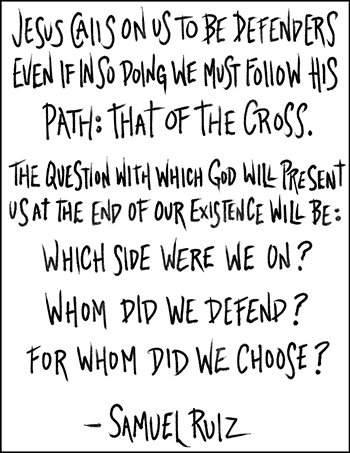Subtotal: $
Checkout-

Christian Nonviolence and Church History
-

American Muslims: Race, Faith, and Political Allegiance
-

Ministers and Magistrates
-

Pick the Right Politics
-

Editor’s Postscript: Notes from the Lockdown
-

Readers Respond: Issue 24
-

Family and Friends: Issue 24
-

What Goes Up
-

The Politics of the Gospel
-

What Are Prophets For
-

Bishop Ambrose
-

The Anabaptist Vision of Politics
-

Jakob Hutter
-

The Bruderhof and the State
-

Saint Patrick
-

Reading Romans 13 Under Fascism
-

Holding Our Own
-

Living with Strangers
-

Tolstoy’s Case Against Humane War
-

Edna St. Vincent Millay’s “Conscientious Objector”
-

Oscar Romero
-

The Martyr in Street Clothes
-

Editors’ Picks Issue 24
-

Van Gogh Comics
-

Boys Aren’t the Problem
-

The Woman Who Carried Me

Next Article:
Explore Other Articles:
To some, samuel ruiz garcía was the “Red Bishop,” a dangerous radical. But to his indigenous parishioners, he was affectionately known as “Tatic” – “father” in their Mayan languages.
Bishop Ruiz was born on November 3, 1924, in Irapuato, Mexico. His parents, poor workers, consecrated their firstborn to the Lord at birth: they were faithful Catholics during a time when clergy were being killed by the secularist government. After studying at Rome’s Pontifical Gregorian University, Ruiz was ordained in 1949. In 1960 he was made a bishop and appointed to San Cristóbal, in the Mexican state of Chiapas.
In Chiapas Ruiz found an apartheid-like society in which the indigenous were treated as subhuman, exploited in semi-slavery on the region’s coffee plantations. “They are God’s people,” Ruiz wrote, “every one of them, just as much as a white person is.”
In 1968, Ruiz attended the meeting of Latin American bishops in Medellín, Colombia, that would prove the birthplace of liberation theology. Inspired by this new approach, Ruiz had scripture translated into indigenous languages. He organized a network of more than twenty thousand indigenous catechists to teach the faith.

“There is not a presence of Jesus Christ until … evangelization,” he explained. But, he insisted, all world cultures have “a revealing presence of God, what the Greek and Latin Fathers called the seeds of the word – semina verbi.” The point of evangelization, Ruiz believed, was not to Europeanize the indigenous but to bring them from their native “Old Testament” to “the explicit encounter with Jesus Christ announced and testified to by the Church.”
In 1993, the United States, Mexico, and Canada ratified the North American Free Trade Agreement (NAFTA). NAFTA’s critics, including Ruiz, claimed that it would encourage the exploitation of impoverished farmers by corporate interests. In a pastoral letter, Ruiz rejected violence in opposing this injustice, but explained that the struggle for peace meant “not only to oppose war … but to adopt an integral position that, through questioning the neo-liberal capitalist system, challenges us also in the justification of violence… . [We must] construct a society in which all fit, without having to sacrifice anyone to conserve peace and order.”
On New Year’s Eve 1993, just before NAFTA went into effect, an armed group emerged from the jungle and occupied San Cristóbal and other cities, taking over radio stations and releasing prisoners. It called itself the Zapatista Army of National Liberation (EZLN), announcing, “We are the product of five hundred years of struggle. And today we say ¡Ya Basta! Enough!” The same evening, government radio falsely charged Ruiz and his clergy with inciting the rebellion. But after a military crackdown had called forth international protest, the authorities knew they needed a mediator, and turned to Ruiz. In 1996, the Zapatistas and the Mexican government signed peace accords.
Surviving several assassination attempts, the last in 1997, Ruiz retired in 1999 and died peacefully in 2011 at age 86.
“Jesus calls on us to be defenders,” wrote Bishop Ruiz, “even if in so doing we must follow his path: that of the cross.”

Artwork courtesy of Jason Landsel.
Already a subscriber? Sign in
Try 3 months of unlimited access. Start your FREE TRIAL today. Cancel anytime.



































